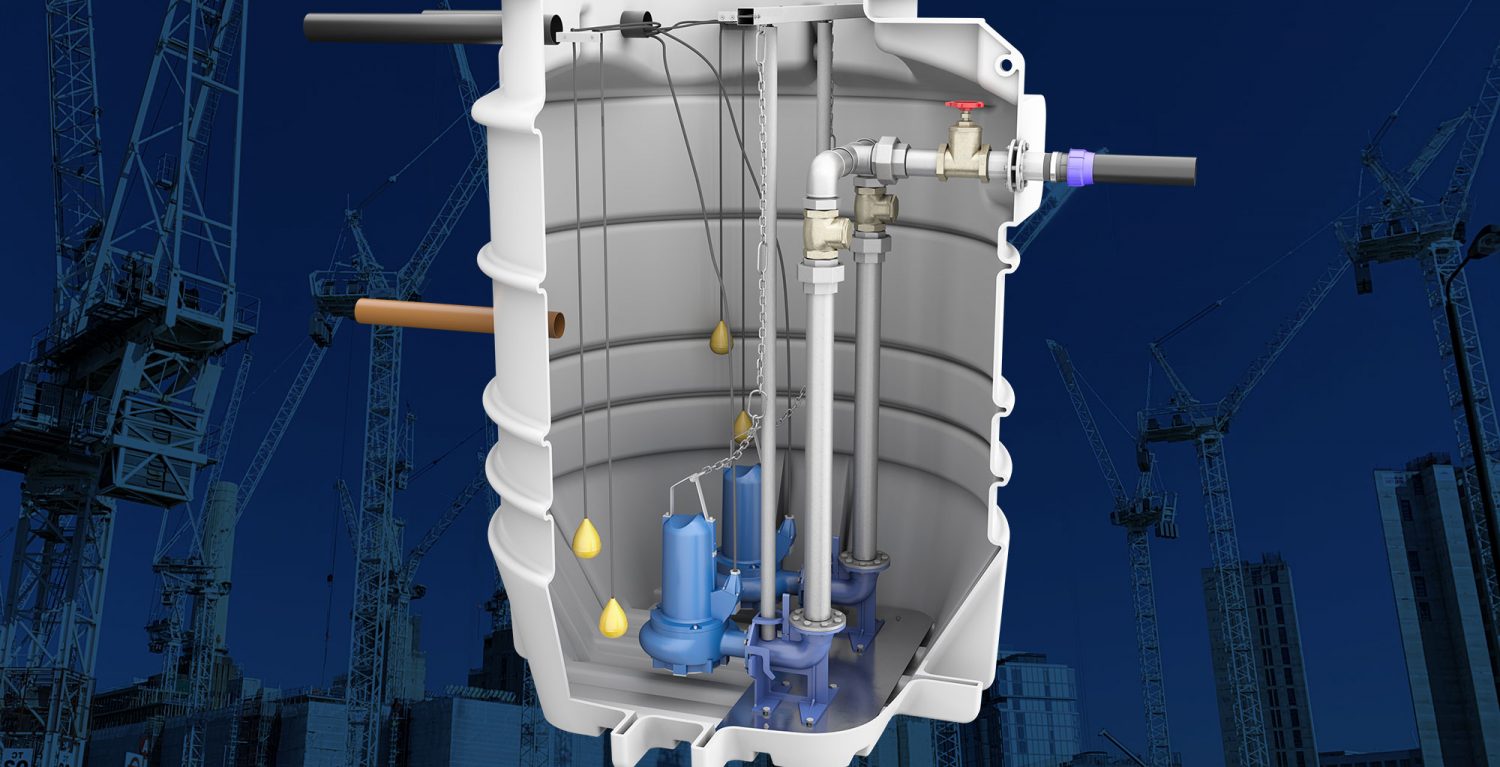What are the benefits of pumping stations generally?
A pumping station is used for pumping all types of wastewater to a final outfall where gravity drainage is not possible. That final outfall is often a main sewer but could also be a storm drain, watercourse, treatment plant, balance pond or even another pumping station.
The pumping station may even be higher than the final outfall, but if a gravity fall of more than 1:40 can’t be achieved, a pumping station will be required to meet Building Regulations Part H.
Pumping stations allow buildings to be constructed in locations where they couldn’t otherwise. An example is where the existing sewer infrastructure cannot be modified due to site constraints or cost.
They also allow buildings to have basements. Main sewers are usual quite shallow, so any waste at basement level will need to be pumped to a high level to facilitate gravity discharge.
What makes a pumping station ‘packaged’?
A packaged pumping station is supplied as a unit which includes the storage chamber and with all its principal components contained within. The chamber is usually polyethylene (MagnaPro) or GRP (MagnaGrand).
Some below-ground pumping stations are not ‘packaged’. These include pumping equipment installed within a concrete or brick sump, or pre-cast concrete rings.
Packaged pumping stations can pump foul, grey, storm, surface and ground waters. We’ll go into more detail on the different wastewater types in a future article.
What are the benefits of a packaged pumping station?
There are many advantages to packaged pumping stations when compared with other types of below ground stations.
They simplify the design process
They are a standard unit which makes specifying easier. The specifications of the pumping station are a known quantity which simplifies the design of the drainage scheme, and the tendering process. It also makes them simpler to integrate into BIM.
Costs and quality assurance
They can be efficiently manufactured offsite in a clean environment with high quality assurance, then transported to site for installation of the chamber followed by commissioning. This is cost effective.
In comparison, installation within a pre-constructed sump requires more time on site which increases costs. The environment can be dirty and cramped which makes it more difficult to achieve the highest quality.
Health and safety
Concrete sumps are usually confined spaces which impacts operative safety and requires specialist training and equipment.
Once the packaged pumping station chamber has been installed, commissioning is a simple task which can be completed very safely.
Less groundworking required. Good design built-in.
Construction of concrete sumps takes longer, and costs more than the civil engineering required to install a packaged pumping station.
They must also be well designed to ensure they function well. They cannot simply be a ‘concrete box’. Bad concrete sump design can build in problems which lead to frequent breakdowns and tanker visits. For example, 60 degree benching must be installed into foul water pumping stations to ensure no dead zones within the chamber.
Depending on the in-house experience of the constructor, a third-party consultant may be required, which can also increase costs.
For an overview of good and bad concrete sump design, check out our article ‘Simple tips for concrete sump design’.
Good packaged pumping station chambers, in particular our MagnaPro range, have built-in features like benching to guide the waste to the pumps for removal.
Environmental protection
Pumping station chambers and sumps are not only temporary storage for the waste but must also be a barrier to prevent the waste from contaminating the surrounding environment.
Concrete sumps and pre-cast concrete ring chambers must be lined, or a specialist concrete mix used, to prevent foul water contamination of the surroundings. Pre-cast ring chambers are particularly vulnerable at the joints between the rings.
Polyethylene or GRP packaged pumping station chambers are impermeable and so provide an effective barrier to the waste.
Structural integrity
Any underground chamber or sump must be able to withstand hydrostatic pressure.
Notably, the joints of pre-cast concrete ring sumps are a point of weakness where failure can occur leading to groundwater ingress.
A well-designed packaged pumping station will be structurally reinforced and have a suitable thickness of wall for the depth and ground conditions.
For example, our award-winning MagnaPro chambers have been optimised using finite element analysis and have been extensively pressure tested. They have strong reinforcing ribs and walls which are thicker for deeper chambers of any given diameter.
When are packaged pumping stations not the best choice?
It mainly comes down to capacity. Sometimes a development requires a large storage capacity, or the invert into the pumping station is exceptionally deep. Which means that concrete sumps are the only option.
For these projects, good sump design is so important. We offer free no obligation advice on concrete sump design. Good design prevents long term issues leading to frequent callouts. Engage us as early as possible in the tendering process so we can maximise your pumping station’s performance and prevent avoidable problems in the future.
For further information or to discuss your project requirements please call 01442 211 554.

